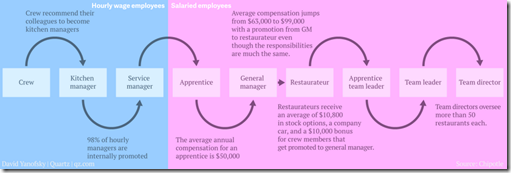Chipotle and education: Upside-down organizations where the best people are removed from the most important positions
/This piece on how Chipotle develops their management team is fascinating. Essentially, the company builds from within, plucking cashier, cooks and other highly effective, downstream employees and rapidly elevating them through training and incentives to management positions.
Last year, nearly 86% of Chipotle's salaried managers and 96% of hourly managers were the result of internal promotions.
Fundamental to this transformation is something Chipotle calls the restaurateur program, which allows hourly crew members to become managers earning well over $100,000 a year.
I became a McDonald’s manager through a similar, albeit less profitable, path. I started working for the company when I was 16 years old. By the time I was 17, I had been promoted to an hourly manager, and less than two years later, I was a salaried manager.
Promoting from within is an admirable and profitable means of identifying and training future managers, but despite this democratic, pluralistic approach, Chipotle, like McDonald’s, is an upside-down organization.
At Chipotle and McDonald’s, the greater your level of advancement, the farther away you step from the customer. In order to climb the corporate ladder at Chipotle, McDonald’s and many other businesses, you must distance yourself more and more from the point of sale. But it’s the point of sale that is the most critical position in the organization in terms of profitability for a consumer-facing company.
It’s where your best people should be.
Time and time again, I would watch highly effective restaurant managers leave their stores for corporate positions, leaving behind a less effective, less profitable managers in their place. These corporate positions generated no profit for the company. Employees in these positions did not interact with customers or drive sales. In McDonald’s and Chipotle and many other businesses, these promotions often remove the most skilled and effective people in the organization from the most critical positions in the company.
I’ve never thought it made much sense.
Sadly, education also operates with an upside-down model. In many ways, the bottom rung of the ladder in education is the teacher. In order to improve your pay beyond a teacher’s salary and climb the career ladder, a person must leave the classroom and become a principal, curriculum specialist, administrator, coach or something similar that removes these people from the most critical position in all of teaching:
The classroom.
If a highly effective teacher wants to increase his or her salary significantly, he or she must step away from students and do work that has a considerably reduced impact on the actual instruction and future of children.
In business terms, these people are stepping away from the point of sale.
People in these positions may try to tell you otherwise. They may say that their work as a principal or administrator or coach helps teachers to be more effective by ensuring adequate training or support or by fostering a climate where both teachers and students can thrive. They often argue that they are indirectly helping more students through their work than a single classroom teacher.
This, of course, is bunk.
If you want to make the greatest difference in the lives of students, become a teacher. The best principal I have ever known would tell you the same.
Sadly, in today’s world, the classroom is viewed by many as a place that must be escaped by many teachers. The list of responsibilities of a classroom teacher is impossibly long and grows longer each year. The number of people, both students and adults, who the classroom teacher must interact with is immense. It is often acknowledged that the classroom teacher has the most difficult position in all of education.
The classroom is not for the faint of heart.
That’s why the position of classroom teacher should be viewed as the most prestigious in all of education. People should not be promoted from the classroom. If anything, people should be promoted into the classroom.
Classroom teachers should be paid the most.
In countries like Finland, which boast the most successful education systems in the world, they are.
In education, if you have an office, you probably need a pay cut. A portion of your salary should probably go to a teacher who works directly with students throughout the day.
If you are not standing in front of students on a minute-by-minute basis during your work day, you probably need a pay cut. A portion of your salary should probably go to a teacher who in the classroom all day long.
Send those dollars where they belong: Into the pockets of teachers.
The people who should be paid the most money in education are the classroom teachers. Rather than having teachers fight like dogs for a scant few administrative positions, our most effective people should be fighting for classroom positions, where they can significantly impact the lives of 20-25 children each year.
Education, like Chipotle and McDonald’s and so many others, is upside down. The goal should be to remain as close to the customer as possible.
Not escape them.
Pay and prestige should be trickling down in these organizations to the people who make the biggest difference in terms organizational success.
Not up.

